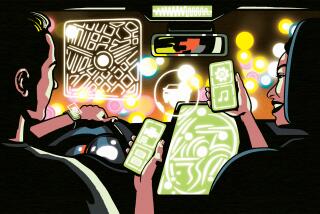GloboCars / THE NEXT CENTURY : The Car of the Future
- Share via
Lost in an unfamiliar neighborhood? Instead of pulling over at the closest gas station, the driver of the future will rely on a voice-activated video display. According to car designers, the car of the future will have many such gadgets to ease driver stress and bolster highway safety. Among the high-tech features in development or under consideration:
1. All-aluminum six-cylinder engine runs on gasoline. To increase fuel efficiency, it shuts down one bank of cylinders for more-efficient, three-cylinder city driving. Optional: a hybrid engine that runs on natural gas or electricity.
2. Sensors installed on roads will provide a variety of navigation tips. Is the Golden State or the Hollywood Freeway your best route north? Check out the navigation display for the latest driving times or Sig-alerts. Are there parking spots available near the mall? The system will show you. Also, available, a CD-ROM library filled with maps of the area. Need a new stereo? Call out your destination and the voice-activated library will display the closest electronics dealers.
3. You’re not alone out there. A system of satellites helps the navigation display determine your exact location. A red dot moves on the display as you move. A blue line shows the shortest route to your destination. Such technology, known as Global Positioning Systems, uses triangulation to pinpoint your position, bouncing the ground signal off of three satellites.
4. Solar panels on the vehicle’s roof help recharge batteries on your car, making them last longer.
5. Collision-avoidance systems located near the rear license plate will detect suprises, such as cars in your blind spot as you back out of the driveway. Using lasers, such systems will alert you to everything from a kid’s bike in the driveway to an 18-wheeler bearing down too quickly. Video cameras may also be incorporated into such systems.
6. Sensors in the door alert you to danger approaching from the right or left. Or, as you try to fit into a tight parking spot, the sensors can tell you how far you are from the curb, the distance to the car behind you, even when to turn the steering wheel.
7. Laser beams scan the road ahead for pedestrians, cars and any another potential hazard. The system determines whether the object is in the way by calculating your car’s speed and direction. If an object enters your “caution zone” and you do not respond to a warning buzzer, the car’s computer may activate an emergency braking system.
Researched by CHRIS ERSKINE / Los Angeles Times






